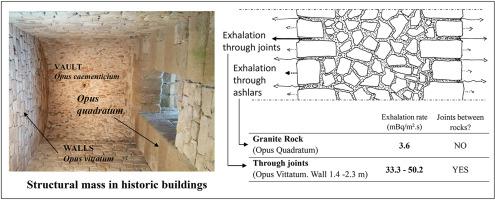Building and Environment ( IF 7.1 ) Pub Date : 2021-05-28 , DOI: 10.1016/j.buildenv.2021.108005 Borja Frutos , Fernando Martín-Consuegra , Carmen Alonso , Gloria Perez , Joaquín Peón , Alberto Ruano-Ravina , Juan M. Barros , Ana M. Santorun

|
The presence of radon in buildings is a matter of growing concern in the industry. A further layer of complexity is present in heritage buildings, where sources of exhalation other than those observed in more modern conventional buildings may render diagnosis and intervention even more difficult. This study explored the high exhalation rates originating in the inner fillers in thick elements such as bearing walls and structural floors and vaults characterising historic construction. They were found to be close to the values observed in soils and one to two orders of magnitude greater (range: 32.5 mBq/m2·s to 149.7 mBq/m2·s) than found in the construction materials themselves, such as granite. The radon emitted into building interiors by those members exhibited more or less uniform concentration profiles on all storeys, irrespective of elevation and consequently distance form the soil. Further to the results delivered by an accumulative model, the only explanation for the empirical findings is that the inner filler in structural members sources a substantial fraction of the high exhalation rates. That would open a new exploratory pathway for remedies that should necessarily address all emissions, rather than deeming the soil as the sole or primary source of radon gas. The issue is broached in this article on the grounds of a case study of the Tower of Hercules at Corunna, Spain, a building dating from Roman times and presently used as a museum and monument open to the public.
中文翻译:

内墙填料作为遗产建筑室内氡污染的单一和重要来源:一种基于呼气方法的方法
建筑物中氡的存在是该行业日益关注的问题。历史建筑中还存在另一层复杂性,在更现代的传统建筑中观察到的呼气源之外的呼气源可能会使诊断和干预更加困难。本研究探讨了源自厚元素(例如承重墙、结构楼板和具有历史建筑特征的拱顶)的内部填充物的高呼气率。发现它们接近在土壤中观察到的值,并且比在建筑材料本身(如花岗岩)中发现的值大一到两个数量级(范围:32.5 mBq/m2·s 到 149.7 mBq/m2·s)。这些成员排放到建筑物内部的氡在所有楼层上都表现出或多或少的均匀浓度分布,无论海拔如何,因此与土壤的距离无关。除了累积模型提供的结果之外,对经验结果的唯一解释是结构构件中的内部填充物在高呼气率中占很大比例。这将为补救措施开辟一条新的探索途径,必须解决所有排放问题,而不是将土壤视为氡气的唯一或主要来源。本文根据西班牙科鲁纳的大力神塔的案例研究来讨论这个问题,这座建筑可追溯到罗马时代,目前用作博物馆和向公众开放的纪念碑。对实证结果的唯一解释是结构构件中的内部填充物是高呼气速率的很大一部分。这将为补救措施开辟一条新的探索途径,必须解决所有排放问题,而不是将土壤视为氡气的唯一或主要来源。本文根据西班牙科鲁纳的大力神塔的案例研究来讨论这个问题,这座建筑可追溯到罗马时代,目前用作博物馆和向公众开放的纪念碑。对实证结果的唯一解释是结构构件中的内部填充物是高呼气速率的很大一部分。这将为补救措施开辟一条新的探索途径,必须解决所有排放问题,而不是将土壤视为氡气的唯一或主要来源。本文根据西班牙科鲁纳的大力神塔的案例研究来讨论这个问题,这座建筑可追溯到罗马时代,目前用作博物馆和向公众开放的纪念碑。











































 京公网安备 11010802027423号
京公网安备 11010802027423号